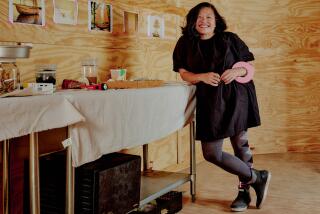Museum Offers Nutritious Art Exhibit
- Share via
SAN FRANCISCO — Like a huge, five-course Thanksgiving dinner, a museum exhibit dedicated to what we eat is challenging the idea that food fails to satisfy as a subject of artistic expression.
“A Feast for the Eye: Food in Art” is a mouthwatering collection of 250 works, few of them the still lifes that people might expect.
How about boxes of Ritz crackers stacked in a supermarket aisle? Or two starving men in turn-of-the-century France boiling shoe leather in a giant kettle? How about a handbag that looks like a loaf of bread?
All are represented in the exhibit, which continues through Dec. 13 at the M.H. de Young Memorial Museum in Golden Gate Park.
Cartoons, photographs, short films, dishware and paintings are just some of the works that illustrate the serious and humorous sides of food as a symbol of wealth and status, as well as a commentary on those left powerless without food.
“I would like people to take away some of the deeper subjects but also to really be able to kick back and say, ‘Holy cow! A hat that looks like a head of lettuce,’ ” curator Melissa Leventon says.
Leventon, who describes herself as an amateur chef, first came up with the idea more than a year ago to showcase the museum’s permanent collection.
There’s no catalog, but the exhibit was timed to coincide with a cookbook published by the Fine Arts Museums of San Francisco. A recipe for stuffed fillet of sole is displayed opposite Gunter Grass’ 1978 surreal etching “Man in Flounder.”
Leventon had hoped to include artwork of actual food but could not because of potential problems with ants, spiders and silverfish at the aging museum.
The pieces are laid out according to the metaphor of a meal, beginning with food and drink, continuing with dining, tableware and subjects for dinner conversation. The final serving is a kind of after-dinner entertainment, an outrageous look at food as art, including a coat made to look like cabbage and a short film showing the effects of sour candy balls on children.
One critic, Jonathon Keats of San Francisco magazine, complained that the exhibit misses the mark because it is organized by subject matter.
“While there’s nothing wrong with displaying objects in an anthropological context, just as there’s nothing wrong with eating a can of soup for lunch, these are not things you do in a fine arts museum,” Keats wrote.
Stomachs may growl as visitors gaze at William J. McCloskey’s sensuous painting “Oranges in Tissue Paper” or David Gilhooly’s cartoon-like “My Daily Bread,” which depicts a gargantuan sandwich that looks like something Dagwood would love.
Then there’s Marianne Boers’ screen prints of boxes of Ritz crackers in a supermarket and bottles of Perrier water. Leventon said the artwork includes the hidden message that our society has become dependent on mass-produced food and drink.
There also are sobering images--a 1949 photograph of a British family eating in squalor, and an Italian POW’s book of recipes meticulously collected from fellow prisoners’ memories of their mothers’ cooking.
Decorative arts on display include a 19th century Peruvian silver spice box that has a lock and key because spices were scarce at the time. Leventon said the majority of such pieces were intended for use at dinner tables, something that is lost when it becomes labeled artwork.
“You can look at a silver sauce boat and you can admire the beautiful chasing and molding,” she said. “But you can also understand that this is something that somebody put gravy in and picked up and poured gravy over whatever was on their plate. This was a useful item.”
More to Read
The biggest entertainment stories
Get our big stories about Hollywood, film, television, music, arts, culture and more right in your inbox as soon as they publish.
You may occasionally receive promotional content from the Los Angeles Times.










